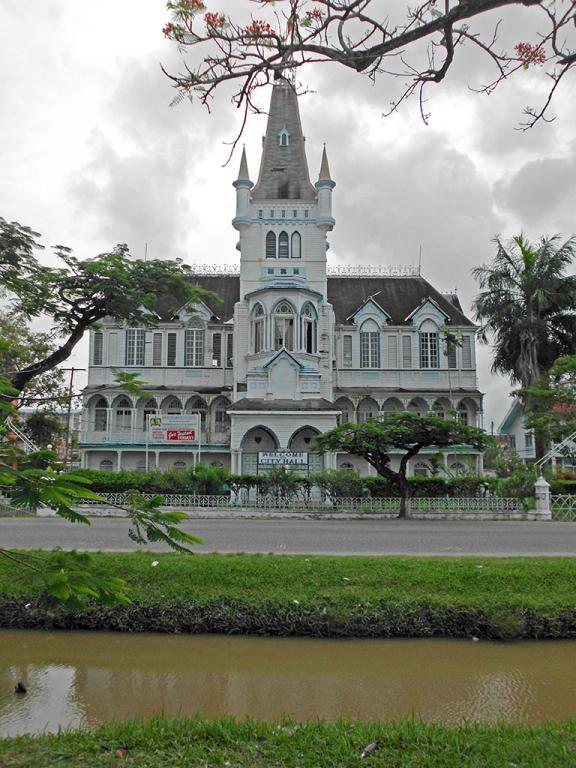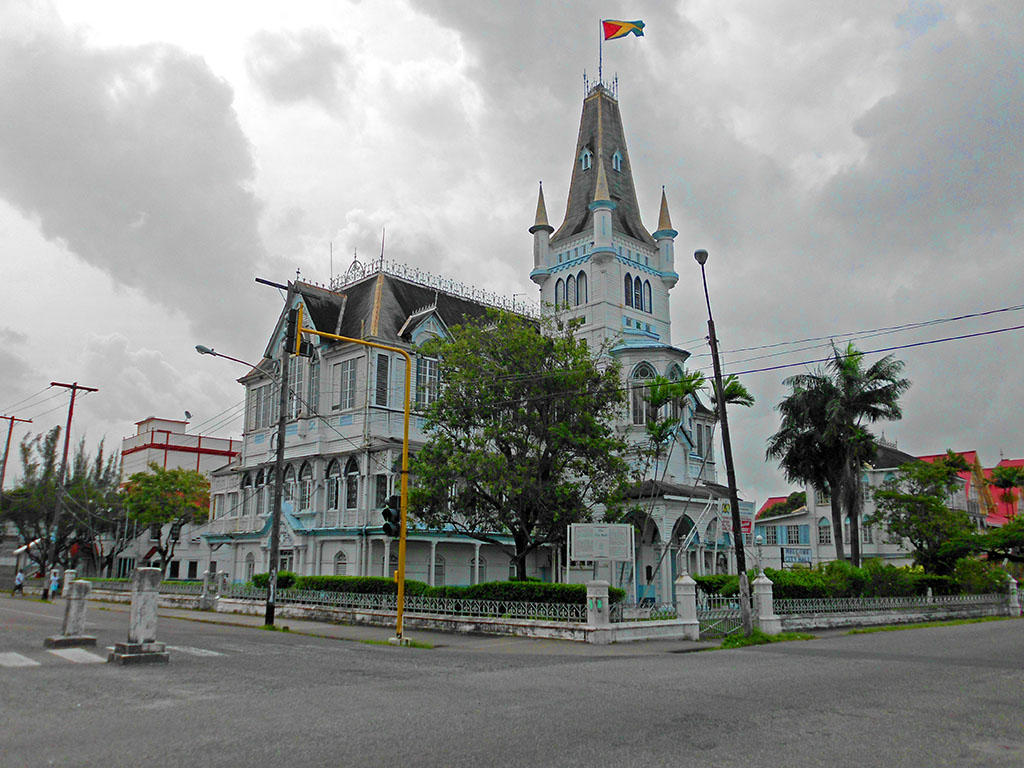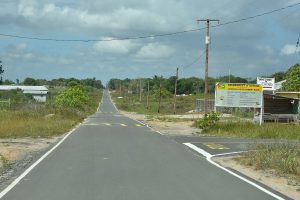Georgetown City Hall, designed by architect Reverend Ignatius Scoles, has been described as one of the finest examples of Gothic Architecture in the Caribbean. It was built between 1887 – 1889. The building is a translation in wood (with cast-iron colums) of what is described as “fancy dress” Gothic, complete with a steeply pitched roof, spire, pinnacles and ornamental wrought iron crenellation. It is built in timber, possesses three floors and has a rectangular shape. The tower – one of the building’s most notable features – is topped by a square, pyramidal, flat-topped spire with the wrought-iron crenelations around the perimeter of the spire’s apex. The spire is surrounded by conical pillars. The building has an elaborate Mahogany staircase which joins the first and second floors of the building. The most picturesque structure in the Garden city is situated in the heart of Georgetown, which houses the office of the Mayor and Town Council of Georgetown. A city council is a group of citizens who are individually elected to serve as the city’s legislative body. The duties of the mayor and council dictate how they will interact with one another. In the council-manager system, the mayor is a “first among equals” member of the city council. In Guyana, the Mayor is chosen from among sitting council members.
In the strong mayor system, the mayor is the chief executive officer of the city government. Councils enact laws and policies that the mayor carries out. Some mayors have veto power over council decision. The mayor’s influence often exceeds the mayor’s official powers.

Front View from Avenue Of The Republic Looking East | Source: https://www.wmf.org/project/georgetown-city-hall
History
On 1 March 1837, the Board of Police, which had managed Georgetown for many years, was replaced by the office of a Mayor and a Town Council through the enactment of an ordinance. The council during its early years had many problems as the city grew. Nevertheless, it preserved and gradually transformed the city.
In 1854, 1862 and again in 1871 it was proposed by the councillors that a town hall be constructed to house the office of the Mayor and Town Council, thus giving them a central location to administer the affairs of the city. Regrettably, these early proposals were shelved due to the council’s inability to secure loans from the government and disagreements about the location.
On 22 November 1886 the Council endorsed another proposal for the erection of a Town Hall. A Committee, Headed by The Mayor, R.P. Drysdale, Jas Thomson and J. D. Smith, was established to review the specifications for the Town Hall. Advertisements were placed in the daily newspapers and Mayor George Anderson Forshaw soon acquired the present site where the City Hall now stands. This plot was occupied by a ‘tumble down coffee logie used for dances.’
On 17 March 1887 the committee met and reviewed the designs submitted. They were assisted by Messrs. J. A. Conyers, a councillor, and the renowned architect, Cesar Castellani. They selected the plan, ‘Damus Petimusque Vicissim’, entered by Reverend Ignatius Scoles S. J., a trained architect who had designed several churches in Europe. For his effort he was awarded a prize of $50, which he declined.
Preparations were hurriedly undertaken and a Government loan was secured. Reverend Scoles was required to prepare working drawings and specifications to enable the Sprostons & Son Company to ensure the timely construction of the edifice.
His Excellency Governor Sir Henry Turner Irving KCMG formally laid the foundation stone at 2:00 pm on 23 December 1887 on the occasion of the jubilee year of the reign of Her Majesty Queen Victoria. The stone was laid at the northeastern corner of the main building along with a glass jar containing the original documents of the building, several coins, copies of the Royal Gazette, the Argosy and the Daily Chronicle and a portrait of Her Majesty Queen Victoria.
Governor Irving remarked that ‘it had been one of his dearest wishes of his heart that he might live to see a suitable town hall erected.’ He added that he was particularly gratified that it had been made possible to commence during his tenure in office.
Moreover, under the supervision of Rev. Scoles and Luke M. Hill, the Town Superintendent, the Town Hall was soon completed in June 1889 at a cost of $54,826,62. This figure represented a combined cost for the acquisition of land as well as the construction of the structure.
On 1 July 1889 at 3pm His Excellency Governor Viscount Gormanston KCMG officially opened the building.
After the guests were seated in the hall of the building, the venerable Archbishop, William Piercy Austin, blessed the structure through an offering of prayers. The Mayor then read an address to the Governor, who in return congratulated the Council on their sterling achievement and formally declared the Hall open to the public.
The playing of the National Anthem by the militia band brought the afternoon’s proceedings to an end and guests were given a tour of the newly constructed structure. The craftsmanship bestowed on the ornate cast iron features and the woodwork was noted for its excellent finish and quality.
The City Hall stands today as an eloquent reminder of Georgetown’s past. Few cities can boast of being in possession of such a magnificent structure and where they do exist, no expense is spared to ensure their survival for the benefit of future generations.
Regrettably, the present state of city hall leaves much to be desired. Residents, visitors and tourists constantly lament the advanced state of deterioration, which will inevitably lead to the loss of an architectural heirloom. Hopefully, the officials responsible at City Hall will be inspired by the rich history of this edifice to restore it to its former glory.
Uses
In addition to housing the offices of the Mayor, the City Council and the City Engineer, Georgetown City Hall houses a Concert Hall which was one of the main venues for concerts and recitals in the city. Musicians that have performed in the Concert Hall of the City Hall include the British Guiana Philharmonic Orchestra; Ray Luck, the Guyanese concert pianist; and the Police Male Voice Choir who held their first ever concert at the venue.
References
- https://web.archive.org/web/20120131210052/http://whc.unesco.org/en/tentativelists/274/
- http://www.landofsixpeoples.com/news502/ns5051950.htm
- https://www.wmf.org/project/georgetown-city-hall







